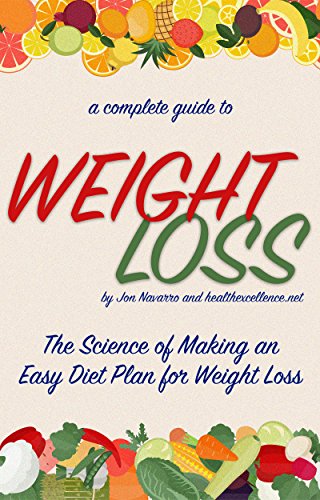
The Science of Weight Loss: A Comprehensive Guide to Effective Dieting
Curious about the secrets behind effective weight loss? Our latest article, “The Science of Weight Loss: Unlocking the Secrets of Effective Dieting,” is here to help! Dive deep into the world of weight loss as we explore the latest research and evidence-based strategies that will arm you with the knowledge needed to create a personalized diet plan tailored to your goals. From understanding macronutrients and meal timing to mastering portion control, you’ll discover everything you need for lasting results. So, if you’re ready to crack the code to successful weight loss, stay tuned for the full article!
Table of Contents
ToggleIntroduction
Welcome to “The Science of Weight Loss: A Comprehensive Guide to Effective Dieting.” In this article, we will explore the intricacies of weight loss and provide you with evidence-based strategies to help you achieve your goals. From understanding the role of calories and metabolism to meal planning and portion control, we will cover every aspect necessary for a successful weight loss journey. So let’s dive in and uncover the secrets to effective dieting!
Understanding Weight Loss
Before we delve into the specifics, let’s first understand how weight loss works. At its core, weight loss occurs when you consume fewer calories than your body burns. This creates a calorie deficit, causing your body to tap into its fat stores for energy. However, the process is more complex than simply counting calories.
The Role of Calories
Calories play a significant role in weight loss. They are the unit of measurement for energy in food. To lose weight, you need to consume fewer calories than your body needs to maintain its current weight. This creates a calorie deficit and prompts your body to use stored fat as fuel.
Metabolism and Weight Loss
Your metabolism, the process by which your body converts food into energy, also plays a crucial role in weight loss. Metabolic rate varies among individuals based on factors such as age, gender, body composition, and activity level. While some people have a faster metabolism, others have a slower one. However, there are ways to boost your metabolism, such as through regular exercise and strength training.
Macronutrients and Weight Loss
Now that we have a basic understanding of weight loss, let’s explore the role of macronutrients in achieving your goals. Macronutrients, namely protein, carbohydrates, and fats, are the three main components of your diet. Optimizing their intake is key to sustainable weight loss.
The Importance of Protein
Protein is an essential macronutrient that plays a crucial role in weight loss. It helps you feel fuller for longer, promotes muscle growth and repair, and has a higher thermic effect compared to carbohydrates and fats. Including ample protein in your diet can increase metabolism and aid in fat loss.
Carbohydrates and Weight Loss
Carbohydrates often get a bad reputation when it comes to weight loss. However, they are a necessary component of a balanced diet. Choosing complex carbohydrates, such as whole grains, fruits, and vegetables, over simple carbohydrates like sugary snacks, can provide sustained energy and promote satiety.
The Role of Fats
Contrary to popular belief, fats are not the enemy when it comes to weight loss. Including healthy fats, such as those found in avocados, nuts, and olive oil, can actually aid in weight loss. These fats provide essential nutrients, improve satiety, and support hormone regulation.
Meal Planning
No weight loss journey is complete without effective meal planning strategies. A well-balanced meal plan ensures that you are meeting your nutritional needs while creating a calorie deficit for weight loss.
Creating a Balanced Meal Plan
When creating a meal plan, aim to include a variety of foods from all food groups while prioritizing nutrient-dense options. Fill your plate with colorful fruits and vegetables, lean proteins, whole grains, and healthy fats. This ensures that you are receiving a wide range of essential nutrients while keeping your calorie intake in check.
The Power of Meal Prepping
Meal prepping can be your secret weapon for weight loss success. By dedicating a specific time each week to preparing meals and snacks in advance, you save time and make healthier choices throughout the week. Portion out your meals, pack them into individual containers, and have them ready to grab when hunger strikes.
Snacking Strategies for Weight Loss
Snacking can be a downfall for many when it comes to weight loss. However, with the right strategies in place, you can enjoy snacks without sabotaging your progress. Opt for nutritious snacks like fruits, vegetables, yogurt, or nuts. Additionally, practicing mindful eating during snack times can help you tune in to your body’s hunger and fullness cues.
Portion Control
Portion control plays a vital role in weight loss. Understanding proper portion sizes and using effective techniques can help you stay on track with your goals.
Understanding Portion Sizes
In a world of oversized portions, it’s important to understand what constitutes a proper portion size. Use visual cues such as your hand or everyday objects to estimate serving sizes. For example, a serving of protein should be approximately the size of your palm, while a serving of carbohydrates should fit into your cupped hand.
The Plate Method for Weight Loss
The plate method is a simple yet effective tool for portion control. Visualize your plate divided into sections: half for vegetables, a quarter for lean protein, and a quarter for whole grains or starchy vegetables. This method ensures a balanced meal and helps you control your overall calorie intake.
Portion Control Tools and Techniques
There are several tools and techniques that can assist you in portion control. Using smaller plates and bowls can create an optical illusion, making your portion appear more substantial. Additionally, measuring cups, food scales, and portion control containers can help you accurately measure your food and avoid overeating.
Meal Timing and Frequency
In addition to what you eat, when and how often you eat can also impact weight loss. Let’s explore the effect of meal timing and frequency on your weight loss journey.
The Effect of Meal Timing on Weight Loss
While the timing of your meals does not directly impact weight loss, it can influence factors such as hunger levels, energy levels, and the overall quality of your diet. Some individuals may find that spacing out their meals evenly throughout the day helps them control their appetite and make healthier food choices.
Intermittent Fasting for Weight Loss
Intermittent fasting has gained popularity in recent years as a weight loss strategy. It involves cycling between periods of fasting and eating. This approach can help control calorie intake and improve metabolic health. However, it may not be suitable for everyone, so it’s essential to consult with a healthcare professional before starting any fasting regimen.
Optimal Meal Frequency for Weight Loss
The optimal number of meals per day for weight loss varies among individuals. Some people may find success with three balanced meals, while others may prefer smaller, more frequent meals or even a combination of both. Ultimately, finding a meal frequency that works for you and aligns with your lifestyle is key.
Exercise and Weight Loss
While diet plays a significant role in weight loss, exercise is equally important. Let’s explore the relationship between physical activity and effective weight loss.
The Role of Exercise in Weight Loss
Exercise has numerous benefits for weight loss. It helps burn calories, increases metabolism, preserves muscle mass, and improves overall health and well-being. Aim for a combination of cardiovascular exercise, such as jogging or cycling, and strength training to maximize fat loss and build lean muscle.
Effective Workouts for Weight Loss
When it comes to choosing workouts for weight loss, the key is to find activities that you enjoy and will stick to in the long term. High-intensity interval training (HIIT) and circuit training are two effective workout styles that can help you burn calories and fat. Additionally, incorporating activities like swimming, dancing, or hiking can make exercise more enjoyable.
Combining Cardio and Strength Training
While cardiovascular exercise is excellent for burning calories during your workout, strength training is equally important for long-term weight loss. Strength training builds muscle, which increases your resting metabolic rate and helps you burn more calories throughout the day. Aim for a combination of both cardiovascular and strength training exercises for optimal results.
Behavioral Strategies for Weight Loss
Weight loss is not solely about diet and exercise; it also involves addressing behavioral patterns and developing healthy habits. Let’s explore some strategies to help you achieve lasting success.
Setting Realistic Goals
Setting realistic goals is essential for maintaining motivation and sustaining long-term weight loss. Instead of focusing solely on the number on the scale, set goals related to healthy habits, such as drinking more water, increasing vegetable intake, or exercising regularly. These small, achievable goals will add up over time and lead to significant results.
Building Healthy Habits
Building healthy habits is crucial for sustainable weight loss. Focus on developing routines that support your goals, such as meal prepping, scheduling regular exercise sessions, or practicing mindfulness. By making these habits a part of your daily life, you are more likely to maintain your progress in the long run.
Mindful Eating for Weight Loss
Mindful eating is a powerful tool for weight loss. It involves paying attention to your body’s hunger and fullness cues, eating slowly, and savoring the flavors and textures of your food. By practicing mindful eating, you can avoid overeating, make healthier food choices, and develop a positive relationship with food.
Managing Cravings and Emotional Eating
Cravings and emotional eating can often derail weight loss efforts. However, with the right strategies in place, you can overcome these challenges and maintain a healthy relationship with food.
Understanding Food Cravings
Food cravings are a common part of weight loss journeys. They can be triggered by a variety of factors, including stress, emotions, or even specific food advertisements. Recognizing your triggers and finding alternative coping mechanisms, such as engaging in physical activity or practicing relaxation techniques, can help you overcome cravings.
Strategies for Overcoming Emotional Eating
Emotional eating is a coping mechanism used to deal with stress, boredom, or negative emotions. To overcome emotional eating, it’s important to address the underlying emotional triggers. Engage in activities that bring you joy and fulfillment, such as spending time with loved ones, pursuing hobbies, or practicing self-care. Additionally, developing healthier ways to manage stress, such as through meditation or journaling, can also help reduce emotional eating episodes.
Healthy Alternatives to Satisfy Cravings
Rather than giving in to unhealthy cravings, there are several healthy alternatives that can help satisfy your sweet or salty tooth. Opt for whole foods such as fruit, yogurt, or unsalted nuts. Additionally, experimenting with healthy recipes or finding lower-calorie versions of your favorite treats can help you stay on track while still enjoying the foods you love.
Sustainable Weight Loss
Finally, to achieve long-term weight loss success, it’s crucial to adopt a sustainable approach. Let’s explore some strategies to help you maintain your progress and make lasting lifestyle changes.
Creating a Long-Term Approach
Weight loss is not a temporary goal but a lifelong journey. Adopting a long-term approach involves making sustainable changes to your lifestyle rather than resorting to quick fixes. Focus on creating a balanced diet, incorporating regular physical activity, and developing healthy habits that you can maintain in the long run.
The Importance of Consistency
Consistency is key when it comes to weight loss. While it’s normal to have occasional setbacks or indulge in your favorite treats, it’s important to get back on track consistently. Remember that small, consistent actions add up to significant progress over time.
Support and Accountability for Weight Loss
Having a support system in place can greatly enhance your weight loss journey. Whether it’s a workout buddy, a support group, or a trusted healthcare professional, having someone to share your goals, struggles, and successes with can provide valuable accountability and motivation.
Conclusion
Congratulations on completing “The Science of Weight Loss: A Comprehensive Guide to Effective Dieting.” Armed with the knowledge and strategies outlined in this article, you are now equipped to create a personalized diet plan that aligns with your goals. Remember, weight loss is not a one-size-fits-all approach, and it may require some trial and error to find what works best for you. Stay committed, be consistent, and believe in yourself. You’ve got this!
Discover the science behind effective weight loss. This comprehensive guide provides evidence-based strategies, from macronutrients to portion control, for lasting results.





